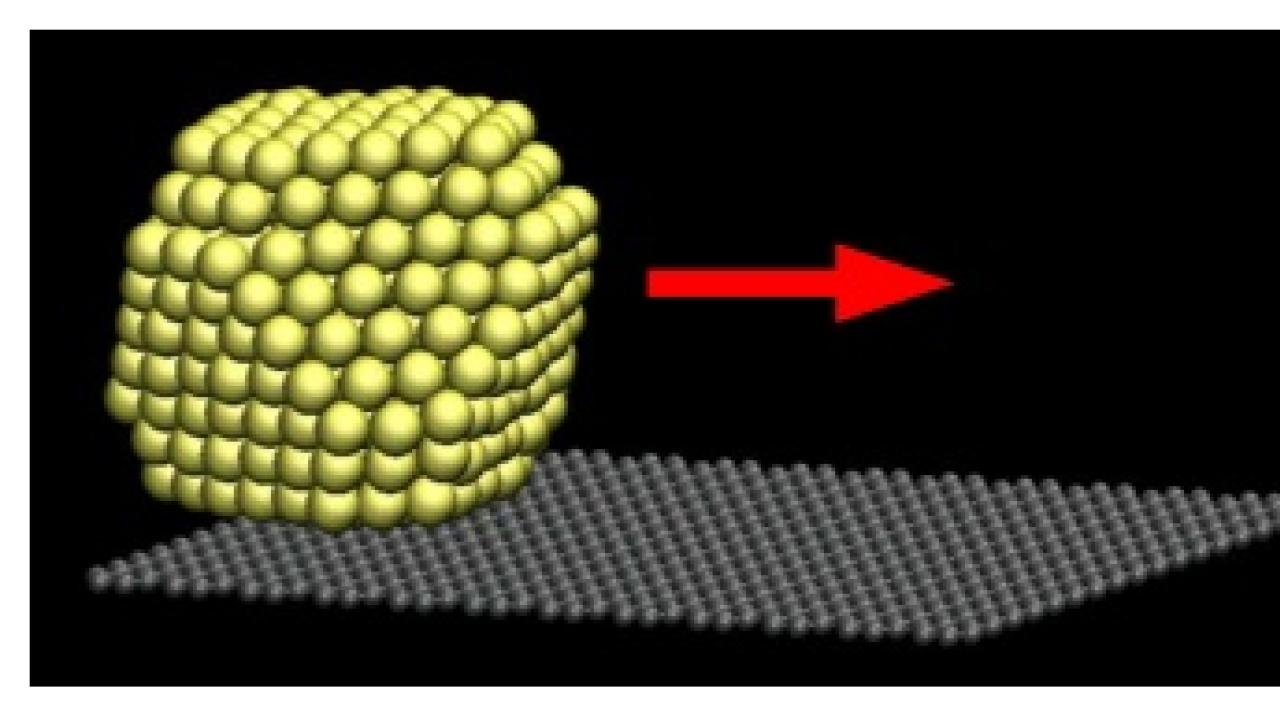
In the macro world, surface interactions are not of great importance to the motion of solid bodies. But at the nano scale, the amount of surface far exceeds the bulk body and so the role of contact adhesion and friction becomes paramount.
Computer simulations prompt physical understanding of friction, which lacks much conventional theory, Tosatti says. They help advance existing technology and applications, he adds, including objects such as nanoelectromechanical systems (NEMS), which integrate electrical and mechanical functions at the nanoscale. Finally, the work allows for possible future extensions of both physics and technological applications.
“Understanding nanofriction is thus a must on more than one account,” Tosatti says. “The ideal tool to make new progress in this kind of situation is computer simulation, where we can conduct a numerical experiment under externally dictated and thus absolutely controlled conditions.”
Tosatti and his co-authors chose to simulate gold clusters on graphite substrates because these clusters were known to diffuse thermally on graphite’s extremely slippery surface. Both in earlier experiments, carried out long ago in France, and in simulations, gold clusters with as many as several hundreds of atoms were seen to display random movements like particles showing Brownian motion. The thermal swells on the graphite substrate's surface make the cluster ‘dance about’ like a dust particle in the atmosphere, a rather unusual sight. Brownian motion is directly linked to the friction experienced in viscous interactions, like those the authors of the paper were studying. The famous relation given by Einstein in 1905 precisely connects the diffusion constant in Brownian motion with the viscous friction. The link suggests that as diffusion increases with an increase in temperature, the friction will decrease. Studying the diffusion yields a value of the friction felt by the cluster, so long as the force and velocity are infinitesimal.
In the case at hand, gold is a crystalline cluster and adheres to the flat crystalline plane of graphite. But the two lattices, gold and graphite, are unrelated, or incommensurate. For such surfaces there are no barriers for motion. So, sliding can be frictionless—a situation sometimes referred to as ‘superlubricity.’ In the first set of simulations, a simulated Au cluster on graphite is seen to immediately glide away, so long as the orientations of the two lattices do not match. But when these angles occasionally fall in registry (the two lattices are in sync), the cluster sticks to the substrate like the pieces of a puzzle. As the cluster rotates unpredictably, it either sticks or slips on the substrate. When the angle is stuck, so is the cluster position, when the angle turns, the cluster glides freely away. Because of Einstein’s connection between diffusion and drift, the same applies to the cluster friction under a very weak force.
The next set of simulations involves delivering a strong ‘kick’ to the cluster to observe the effects of ‘ballistic’ friction at higher speeds. In some cases, a spin was applied with the kick, quite like a curve ball. Here the cluster becomes a sort of projectile, slowed down just by substrate friction. Under the force of computational ‘kicks’ of 100m/s, the friction the cluster experiences is viscous, proportional to velocity, and does not drop exponentially with temperature. There is an inverse correlation between rotational and translational motion. Like drift friction, ballistic friction is viscous. A plot of the overall kinetic energy decay of the cluster with time is well represented by a single exponential as long as the friction is proportional to velocity. Tosatti explains this result as analogous to the kicked cluster being like a raft riding over rough sea. Friction is caused by when the raft bumps over thermal surface asperities or 'waves'. The higher the speed, the larger the number of 'waves' the raft must negotiate, and the larger the friction, a totally different reason from that yielding viscous friction in Brownian motion.
In the first case, the translations and rotations occurred together, or not at all. Here, they are still correlated, but in exactly the opposite way they are in Brownian drift. In ballistic motion, a translational slowdown coincides with a rotational speedup, and vice-versa. The two separate kinetic energies show large bumps corresponding to these translation-rotation transfers, whereas the overall drop of total kinetic energy is much more placid. Ballistic friction no longer drops with temperature, but rather increases with it.
These are the main conclusions of the paper: Two distinct regimes are seen in nanofriction, with a co-relation of diffusion and friction seen in the slow drift and an anti-correlation seen in the fast drift. The effect of temperature on each is the opposite. The latter has several new interesting features that distinguish it from the former. Experiments are now called for to test these predictions, and characterize ballistic friction
“Who knows,” says Tosatti. “This understanding might even come of use when humans will have to take to rockets and cross atmospheres at high speed while migrating to other planets.”
















